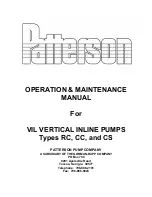
OM−01912
60 SERIES
OPERATION
PAGE C − 2
STARTING
Consult the operations manual furnished with the
power source
.
OPERATION
Leakage
No leakage should be visible at pump mating sur-
faces, or at pump connections or fittings. Keep all
line connections and fittings tight to maintain maxi-
mum pump efficiency.
Liquid Temperature And Overheating
The
maximum
liquid temperature for this pump is
160
_
F (71
_
C). Do not apply it at a higher operating
temperature.
Overheating can occur if operated with the valves
in the suction or discharge lines closed. Operating
against closed valves could bring the liquid to a
boil, build pressure, and cause the pump to rup-
ture or explode. If overheating occurs, stop the
pump and allow it to cool before servicing it. Refill
the pump casing with cool liquid.
Allow an over-heated pump to com-
pletely cool before servicing
.
Do not re-
move plates, covers, gauges, or fittings
from an over-heated pump. Liquid with-
in the pump can reach boiling tempera-
tures, and vapor pressure within the
pump can cause parts being disen-
gaged to be ejected with great force. Af-
ter the pump cools, drain the liquid from
the pump by removing the casing drain
plug. Use caution when removing the
plug to prevent injury to personnel from
hot liquid.
Strainer Check
If a suction strainer has been shipped with the
pump or installed by the user, check the strainer
regularly, and clean it as necessary. The strainer
should also be checked if pump flow rate begins to
drop. If a vacuum suction gauge has been in-
stalled, monitor and record the readings regularly
to detect strainer blockage.
Never
introduce air or steam pressure into the
pump casing or piping to remove a blockage. This
could result in personal injury or damage to the
equipment. If backflushing is absolutely neces-
sary,
liquid pressure
must be limited to 50% of the
maximum permissible operating pressure shown
on the pump performance curve (see Section E,
Page 1).
Pump Vacuum Check
Since this pump does not have a suction check
valve, the discharge line must be fitted with a check
valve if a pump vacuum reading is to be taken.
With the pump inoperative, install a vacuum gauge
in the system, using pipe dope on the threads.
Block the suction line and start the pump. At oper-
ating speed the pump should pull a vacuum of 20
inches or more of mercury. If it does not, check for
air leaks in the seal, gasket, or discharge valve.
Open the suction line, and read the vacuum gauge
with the pump primed and at operation speed.
Shut off the pump. The vacuum gauge reading will
immediately drop proportionate to static suction
lift, and should then stabilize. If the vacuum reading
falls off rapidly after stabilization, an air leak exists.
Before checking for the source of the leak, check
the point of installation of the vacuum gauge.
STOPPING
Never halt the flow of liquid suddenly. If the liquid
being pumped is stopped abruptly, damaging
shock waves can be transmitted to the pump and
piping system. Close all connecting valves slowly.
On engine driven pumps, reduce the throttle
speed slowly and allow the engine to idle briefly be-
fore stopping.















































